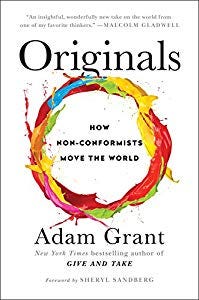
The original Originals video from Apple paints a vivid picture of what innovators are like. They are “the rebels, the troublemakers, the round pegs in the square holes… the ones who see things differently — they’re not fond of rules…”
But what if our assumptions about innovators was very wrong? What if the innovators were very much like the rest of us, with some key differences? And what if we — the ordinary people — could be a lot more original and innovative in our day to day?
That is the premise of the book Originals by Adam Grant.As a Product Manager, and as an Entrepreneur, it is one of the most valuable books I have read in the past several years. Not only did it make me think of Originals in a new way; it provided a lot of actionable advice that I can apply as a Product Manager today.

Cliff notes
- Being original is a choice .Successful Originals are not that different from the rest of us. Being risk-averse and intentional is an asset, if we know how to harvest it.
- Finding the right idea to work on an art. Specifically, it’s not about just idea generation. It’s more about generating a large number of ideas and then being able to pick the top ideas from the list with the help of fellow creators.
- Getting your idea accepted takes work. You are more likely to get the idea accepted if you work from within the system, increase people’s familiarity with the idea over time, and if you are upfront about its downsides.
- There are two ways to keep yourself motivated on the long journey of making your idea a reality. When your motivation is wavering, focus on how far you have already come on making the idea a reality. When your motivation is strong, focus on how far you have to go still and what the vision is.
Now let’s dig in to the details.
Originality is a free choice
The hallmark of originality is rejecting the default and exploring whether a better option exists. — Adam Grant, Originals
It’s important to explore why the default exists in the first place. As another of my favorite books called “On Confidence” which puts it as follows.
The majority of what exists is arbitrary, neither inevitable nor right, simply the result of muddle and happenstance.
A lot of successful Originals are not crazy risk takers. Being risk-averse is an asset; risk aversion increases your odds of starting a successful new venture. Entrepreneurs who kept their day jobs had 33 percent lower odds of failure than those who quit.
But if you are risk averse, you are much less likely to start a business, right? Seems like we are back to square one.
The key, according to Adam, is to treat risks as stock portfolios. To balance them. Find areas where you have social stability, financial stability, emotional stability. Keep them where they are. Then take a huge risk in one area. Don’t spread your risks across a bunch of areas. You will be unlikely to really be able to take big risks that pay off big. What you need to do is to take a huge risk in one area and keep everything else constant and stable.
Think of the areas of stability as the weights that keep your launching pad stable, that enables you take off towards your destination.
Even Bill Gates minimized risks. He did not even technically drop out of Harvard. He got a leave of absence approved byHarvard, had his parents bankroll him, and waited till one year after he had successfully sold programs as a sophomore before leaving school.
For Product Managers, this applies as much to products. Innovate on one or two key areas. Keep everything else standard, mundane, as expected. Balance your product investment accordingly. Try to have one moonshot project, and lots of incremental improvements, maintenance etc. Innovating all areas is a recipe for disaster.
Generating Ideas
Most Originals were most innovate when they came up with a large number of ideas. Shakespeare produced 37 plays and 154 sonnets. A lot of them were subpar. The ones that stood our really did very very well, as we know.
But generating a large volume of ideas does not come naturally to most people. We need the time and the discipline to generate more ideas. Our first ideas or often too close to what already exists. As we keep generating ideas, they get weirder. Then get some amazing ones.
This is a common practice at Upworthy, where copywriters are required to generate at least 25 headlines for each article.
But there is a second issue here. That of timing.
Most people generate ideas, and expect to have a great version by the end of that session. That doesn’t work in most cases. Creative works requires a different approach.
It pays to procrastinate strategically.
Try this. Think of an idea. Then put it aside. Let it marinate. Let your subconscious mind work on it. Make sure you have the time to do this, with relaxing activities that let your mind work on it behind the scenes.
For me, these activities are meditation, showers, driving, and walking.
They key is to have a notebook at hand at all times where you can write these down. Well, maybe not in the shower.
It is important you don’t polished the idea too much. Our brain tends to keep working on incomplete tasks and ideas; if it senses that the work is done, it stops working on it.
This is why at any point, I have 5 product ideas, blog posts, ideas for new classes in action. It pays to write them down, then come back, polish. It’s okay. You are not lazy. You are being strategic.
Selecting the right idea to work on
Originals struggle to pick the right idea to focus on . And managers are no good at picking ideas. No. What might be the best predictor is peers evaluating each other.
By this, we mean peers who themselves are originals and creatives in the field you are working in. This could be engineers working on your product, product managers working on similar or adjoining products, and so on and so forth.
Try this exercise. When you are evaluating one or more ideas. Then go to your fellow Product Managers and ask them to drill you with questions. With no expectation that I will be able to answer them. Each question will give you a new perspective, and enable you to dig deeper into a problem. Then ask them to pick.
But there is one more aspect that’s important: that of mindset. Make sure your fellow PMs don’t come in with a manager mindset; that they have a creative mindset. A manager mindset is about minimizing risks; so managers are likely to fit what fits their mental model of what is good. Which will be similar to other ideas that they previously accepted as good.
To get them into the creative mindset, ask them to generate some ideas. Adam says six minutes is what you need to get into the creators mindset. That will enable your fellow PMs to pick the right ideas.
The other issue in picking the right idea is differentiating the quality of idea from the passion expressed by the person who generated the idea. We know some people are just good at getting other people excited by their idea. And if they have a track record of success, it’s even easier to persuade people.
But that is not a good predictor of how successful the idea would be.
You have to track not whether people have been successful, but how they have been successful. And here what you need to look at whether the person has the past track record of executing on the ideas they expressed. Have they struggled through obstacles, and come out the other end through better execution and improvements?
As Mark Suster writes so well here, Invest in Lines, not Dots.
Keeping motivation high as you work through ideas
Even if you have the right idea, there is always the struggle. As Brendon Bouchard says “Honor the Stuggle.”
But how do you keep yourself motivated? And how do you keep your team motivated through this journey.
There are two weapons: one is how far you have come, and the second is how big your vision is and how much room there is still there to achieve more.
Here is when you use each.
When you find your motivation wandering, focus on how far you have come. Think through the difficulties you already went through, the challenges you tackled, the effort you put, the customers who you helped succeed. Use that to make your motivation and your desire unwavering.
When you find your motivation firm, focus on the future. Visualize how much more you can achieve, think about what this thing could look like five years from now, ten years from now. Think what it would look like if you were 10X more successful.
Getting your idea accepted
Last, but not least, you have to get your idea accepted and bring on board other people. There is no silver bullet here; just lot of lead bullets. Here are some things that help.
The first one is exposure and familiarity. People are quick to reject things that are unfamiliar. That is okay. Keep trying. And progress slowly. Introduce the idea to them in brief at first. Even if they react negatively, tell them to consider it. Let them marinate on it. Then come back a few days later with more details. As people know more about the idea and spend more time with it, the shock factor will go away. As Marissa Peer says:
Your mind is hardwired to resist what is unfamiliar and to return to what is familiar.
Next, be upfront about downsides. This has several upsides, but the two biggest ones are that :
- People trust you more. If you are willing to share the downsides so readily, what you say about the upside must be true
- It leaves audiences with a more favorable assessment due to a bias in how we process information. If you already shared the downsides, the audience will have to work harder to identify more downsides. This leaves them with the impression that your idea is not that bad anyhow!
Last, but not least, work from within the system. We all love the story of the rebel who completely went against the system, brought the system down, and changed everything. Makes for good TV.
Most of the times though, you need help from other people who have influence. So find the other people who think like you do.
Bring them along. And us their influence to bring others along.
This step always takes more than you would expect, but be patient. Keep working on it.



